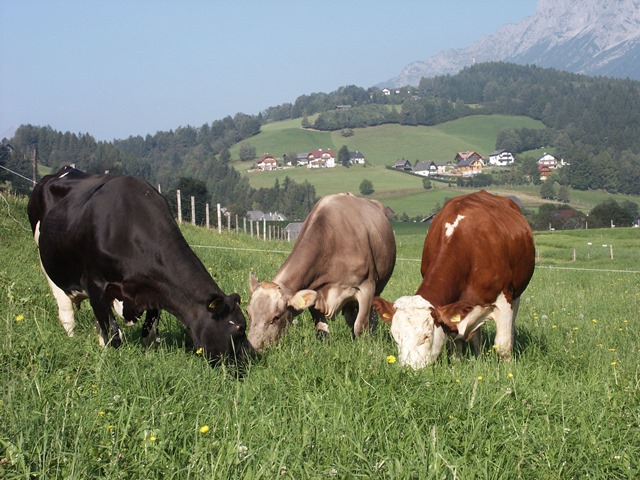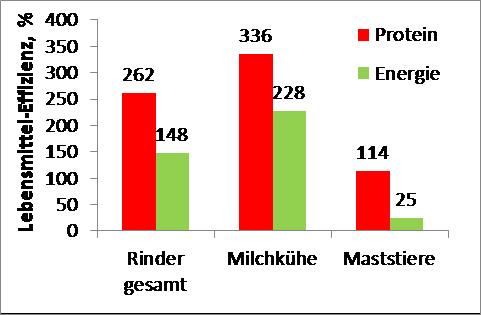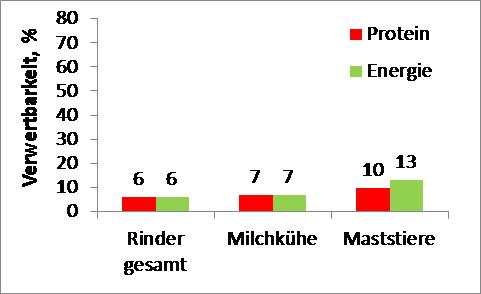Study
to estimate the feed content in rations of Austrian farm animals with direct potential use in human nutrition
Authors:
Magdalena Schönauer (University of Natural Resources and Life Sciences), Priv.-Doz. Dr. Andreas Steinwidder (Bio-Institut HBLFA Mag Raumberg-Gumpenstein) and AoUniv.Prof. Dr. Werner Zollitsch (Institute of Livestock Sciences University of Natural Resources and Life Sciences)
Cooperation partners:
HBLFA Raumberg-Gumpenstein: A. Steinwidder (Bio-Institut) and K. Krimberger;
University of Natural Resources and Life Sciences Vienna: W. Zollitsch, P. Ertl and M. Schönauer (Institute for Livestock Sciences)
Master's thesis February 2016:
Magdalena Schönauer (Institute of Livestock Sciences, University of Natural Resources and Life Sciences Vienna and Bio-Institute of the HBLFA Raumberg-Gumpenstein)
This is how the calculation was made:
The data from the Austrian feed balance provided the basis for the study. In this, the feed used annually in Austria is assigned to the livestock categories. Based on a literature search, yields and processing figures were derived for all plant raw materials and a percentage usability for direct human nutrition was calculated for each feed. This was done separately for protein and energy in the respective feedstuffs. In a further step, the edible portions of the feed rations used were compared with the edible output of animal products (milk, meat and some of the slaughter by-products). The quotient of this is also known as the food conversion efficiency (LKE). LKE results over 100% indicate that more protein or energy is produced in the form of animal foods in the respective animal production system than is used in feed.
Figure 1 : Rations with a high proportion of grassland forage perform positively

Grassland feed share is important
Grassland feed (green fodder, hay, grass silage, etc.) cannot be used directly for human nutrition. On average, the proportion of grassland fodder in Austrian cattle rations is between 70 and 75%. Therefore, the feed rations of the various categories of cattle in Austria had low usability for direct human nutrition with values below 10% (Figure 1 left). However, national and international studies also show that significant differences can be expected depending on the feeding strategy (company, region, country, etc.).
Food efficiency
Figure 2 (below) shows the results of food conversion efficiency for all cattle, dairy cows and fattening bulls in Austria. Not least because of the low usability of feed for direct human nutrition, the food conversion efficiencies (LKE) of Austrian cattle farming are currently clearly positive compared to the national average, as almost all values are above 100%. This means that Austrian cattle farming currently makes a positive contribution to the available amount of edible protein and edible energy. However, studies show that the food efficiency of cattle does not always have to be that high, but rather depends very much on the feeding strategy. For example, grain-based cattle feedlots in the UK had LKEs of just 33% for protein and 16% for energy (Wilkinson 2011). This means that only about a third of the edible protein used in the feed and about a sixth of the edible energy is recovered in the form of animal products. These production systems thus divert protein and energy in the form of potentially consumable feed, thereby reducing the amount of food available globally. However, the proportion of grassland forage in this study was only around 4%. Ertl et al. (2015) evaluated individual farm data from Austrian dairy farms. This work showed average values comparable to our own work; However, on an individual farm basis, the LKE for protein varied between 79 and 352% and for energy between 60 and 286%.
Figure 2 : Current direct usability of protein or energy in cattle feed rations for human nutrition (top) and food conversion efficiency in cattle farming in Austria (bottom) (Schönauer et al. 2016)


Conclusions
In addition to animal performance, food conversion efficiency is particularly influenced by the feed used. The results in this regard worsen with increasing feeding intensity or the use of high-quality arable crops. In contrast, grassland-based cattle farming and the use of inedible industrial by-products make a valuable contribution to the food supply. In Austria, permanent grassland is the predominant crop type. Agricultural use of these areas is largely not possible and is also undesirable for ecological reasons. Since only ruminants are able to efficiently convert the feed from grassland locations into food, grassland-based ruminant farming makes a valuable contribution to the food supply. However, if feeding is intensified, a deterioration in food efficiency must be expected.
Press release: Are cattle efficient food suppliers?
{rsfiles path="General/Biological_Landwirtschaft_und_Biodiversitaet_der_Nutztiere/40_2016_pressetext_lebensmittelsicherheit.pdf"}
You can request the complete final report via the following email address:





